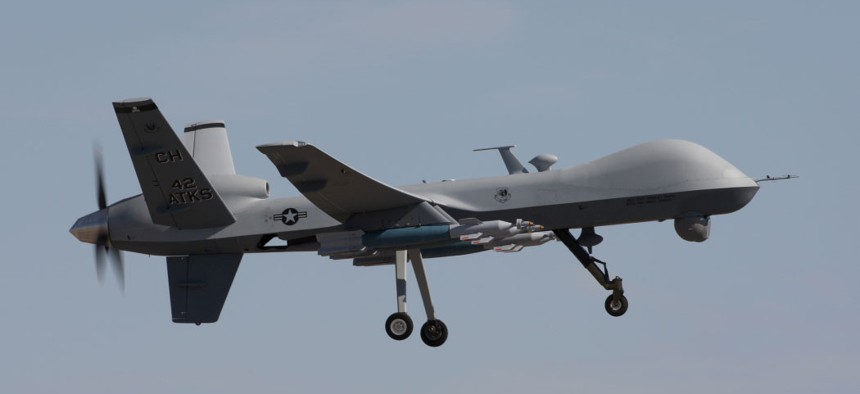
Drone maker demos a detect-and-avoid system for its lead UAS
Reaper and Predator manufacturer General Atomics puts its Due Regard Radar to the test, while also achieving a new flight endurance record for the Reaper.
In a pair of recent announcements, General Atomics, manufacturer of the MQ-1 Predator and MQ-9 Reaper, outlined strides it has made in its famed unmanned aerial system platforms. The first was a successful operational test of a detect-and-avoid system aboard a Customs and Border Protection Guardian UAS – a maritime variant of the Reaper – and the second was the longest endurance flight of a modified Reaper aircraft.
The detect-and-avoid system, General Atomics’ Due Regard Radar, is an air-to-air radar designed to enable flight in international airspaces. The DAA system includes Honeywell’s Traffic Alert and Collision Avoidance system and Sensor Tracker, which is specifically designed for DAA, General Atomics said.
The DAA system detects and avoids cooperative and non-cooperative aircraft. Its features also include high-performance, actively electronically scanned array antenna, an air-cooled antenna and radar electronics assembly, the ability to detect and track any aircraft in field of vision no matter the onboard equipment, the ability to feed tracks through the DAA system to a remote pilot and the facility of full and safe integration of drones into national airspace.
Detect-and-avoid systems, also known as sense-and-avoid, must be installed in all commercial and military aircraft and has been one of the primary restrictions holding back greater adoption of UAS into the U.S. national airspace by the Federal Aviation Administration, much to the dismay of even government officials. “We can probably work out a [Certificate of Waiver or Authorization] and carve out a piece of airspace to work these smaller platforms in, but there’s still no rules issued to actually operate these things big picture across the board,” a frustrated Maj. Gen. Randolph Alles, CBP’s Executive Assistant Commissioner, told the House Homeland Security Subcommittee at a hearing that discussed the potential use of small, tactical drones to help secure the borders. “I can’t operate [UAS] in the airspace, the FAA won’t let me…the rules still prevent that. Until we can move beyond those and really get open use of the airspace with the Predator, that’s going to be a limitation.”
A report issued by the Rand Corp also indicated the FAA has restrained greater government use of these platforms. Additionally, the report highlighted the key differences between the Reaper and its maritime variant, the Guardian, which are the sensors. The Guardian carries a maritime search radar originally developed for the Navy to detect enemy submarines periscopes at sea called SeaVue used to detect small targets in maritime domains as well as a modified electro-optical sensor for improved capability in the maritime environment.
General Atomics’ recent flight test builds off similar demonstrations that took place last year, many in the California desert aboard the Reaper.
“The successful completion of our anti-collision radar system operational testing by CBP is a huge milestone for our DAA system as it represents the first integration and evaluation of DRR on an operational UAS,” said David Alexander, president, Aircraft Systems at General Atomics. “CBP's follow-on operational use of the DAA system in domestic and international airspace will further validate the work being done by the FAA and NASA to introduce [remotely piloted aircraft] into the National Airspace System.”
General Atomics described test demonstrations, which entailed “intruder” aircraft such as a Cessna C-210 and UH-60 Black Hawk with various Mode A/C Transponders, TCAS, and Automatic Dependent Surveillance-Broadcast (ADS-B) transponder capabilities flying near a Guardian. Onboard sensor data was combined and downlinked to the pilot’s traffic display with DAA-specific alerts and guidance, which provided safe separation between both aircraft. The tests demonstrated a clear operating picture to UAS operators and proved DAA can coexist with other radar payloads on the same aircraft, such as the SeaVue. Overland tests began near Palmdale, Calif on March 10 and concluded April 25 over the Pacific Ocean.
As for the endurance flight of the Reaper, General Atomics’ Alexander said “This long-endurance flight demonstrates Predator B Big Wing's game-changing potential for providing life-saving persistent ISR [Intelligence, Surveillance, and Reconnaissance] in support of U.S. and coalition warfighters.” The “Big Wing” is a reference to a retro fit extending the wing size of the Reaper 13 feet to 79 feet, which was announced earlier this year.
“Our company continually strives to extend Predator B’'s already impressive endurance further, pushing the aircraft's capabilities to its full potential,” Alexander added of what the company describes as the next-generation derivative of the combat-proven Reaper.
The aircraft was capable of launching, climbing to an operational altitude, loitering and conducting various maneuvers after 37.5 hour of continuous activity without incident in the recent demonstration. The retrofit improves endurance time from 27 to 42 hours.
Earlier versions of this particular aircraft included two wing-mounted fuel tanks, which the Air Force currently employs in operation called the Reaper Extended Range.
NEXT STORY: Navy says hit me again with Blackjack UAS